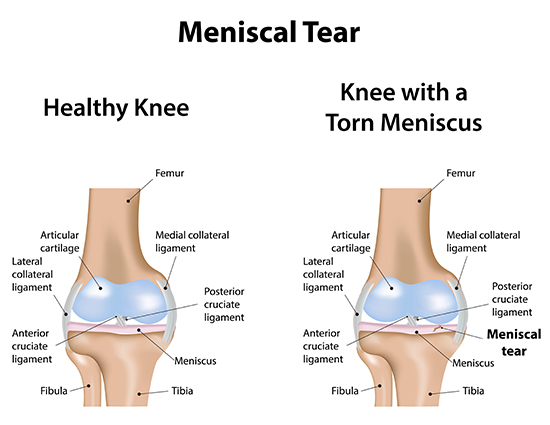
What is a meniscus tear?
The meniscus is a rubbery disk of soft cartilage that helps cushion the knee joint on both the medial and lateral side. They are attached firmly around the edges of the proximal tibia. Tears of the meniscus can be present in all shapes and sizes. Common tears include bucket handle, flap, and radial. When they occur, they can be very painful.
How does a meniscus tear occur?
Many meniscus tears occur doing sports with a squat or twisting type movement or with direct contact. Older people may acquire degenerative tears from long-term stress.
What are the symptoms of a meniscus tear?
The most common symptoms are pain, stiffness of the knee, swelling, catching or locking, or a feeling of the knee giving out. Ninety percent of the time symptoms are apparent on the inside of the knee.
How is a meniscus tear diagnosed?
A complete history and physical exam will be performed. There is usually tenderness along the affected knee’s joint line and a positive McMurray test. This test is performed by bending, straightening, and rotating the affect knee. A click will be heard with this movement. X-rays and an MRI will be done to confirm your meniscal tear diagnosis and rule out any other pathology. Both physical exam and MRI are helpful, but the patient history and exam are the priority to treatment.
How is a meniscus tear treated?
If the tear is small and you are having minimal symptoms, you will follow the RICE protocol: Rest, Ice, Compression, and Elevation. NSAIDs will help reduce inflammation and swelling. Riding the recumbent bike is one of the best exercises to rehabilitate from knee pain in order to avoid re-injury and allow internal maximal healing to occur.
Steroid injections may be given if more conservative measures fail, or in severe injuries.
However, surgical intervention is usually needed. Meniscal tears are repaired through minimally invasive arthroscopic surgery by taking out the torn piece of meniscus or suturing the pieces back together. This procedure is done as outpatient surgery with no hospital stay, with a 30 minute (meniscectomy) to 1 hour (meniscal repair) operating time, and only 5 hours in the ambulatory surgery center.
What is the recovery time for meniscus tear repair?
Recovery time varies based on the extent of the tear and the individual patient’s healing process. Crutches may be used for a few days while range of motion (ROM) and strengthening exercises are performed at home or with physical therapy depending on your needs. Most patients return to work in 3-7 days with light duty and are back to full activities in 2-4 weeks.
Most of our patients are able to recover with our custom-tailored home exercise program which you will do on your own three times a day. You will be evaluated at your 2-week post-op appointment and outpatient physical therapy may be recommended at that time as an option to help speed the recovery process.
A meniscal tear is the most common injury to the knee in all ages of patients. It is easy to diagnose and treat and if caught early, the recovery is brief with minimal pain and swelling. Patients are able to progressively return to a normal active lifestyle.
We are here to help. If you believe you are suffering from a meniscus tear, we would love to deliver a diagnosis, get you treated and get you moving again.


